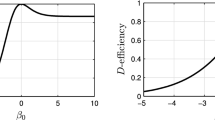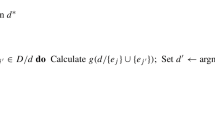Abstract
This paper generalizes Kunert and Martin’s (Ann Stat 28:1728–1742, 2000) method for finding optimal designs under a fixed interference model, to find optimal designs under a mixed interference model. The results are based on the properties of information matrices in fixed and mixed models given in Markiewicz (J Stat Plan Inference 59:127–137, 1997). The method is applied to find a design which is optimal for any given variances of random neighbor effects.
Similar content being viewed by others
References
Andersson LE, Chang G, Efving T (1995) Criteria for copositive matrices using simplices and barycentric coordinates. Linear Algebra Appl 220:9–30
Bhatia R (2003) Partial traces and entropy inequalities. Linear Algebra Appl 370:125–132
David O, Monod H, Lorgeou J, Philippeau G (2001) Control of interplot interference in grain maize: a multi-site comparison. Crop Sci 41:406–414
Druilhet P (1999) Optimality of circular neighbor balanced designs. J Stat Plan Inference 81:141–152
Filipiak K, Markiewicz A (2003) Optimality of neighbor balanced designs under mixed effects model. Stat Probab Lett 61:225–234
Filipiak K, Markiewicz A (2004) Optimality of type I orthogonal arrays for general interference model with correlated observations. Stat Probab Lett 68:259–265
Filipiak K, Markiewicz A (2005) Optimality and efficiency of circular neighbor balanced designs for correlated observations. Metrika 61:17–27
Gill PS (1993) Design and analysis of field experiments incorporating local and remote effects of treatments. Biometrical J 35:343–354
Jones B, Kunert J, Wynn HP (1992) Information matrices for mixed effects models with applications to the optimality of repeated measurements designs. J Stat Plan Inference 33:261–274
Kiefer J (1975) Construction and optimality of generalized Youden designs. In: Srivastava JN (ed) A survey of statistical design and linear models. North-Holland, Amsterdam, pp 333–353
Kunert J, Martin RJ (2000) On the determination of optimal designs for an interference model. Ann Stat 28:1728–1742
Kushner HB (1997) Optimal repeated measurements designs: the linear optimality equations. Ann Stat 25:2328–2344
Li Ch, Mathias R (2000) Extremal characterizations of the Schur complement and resulting inequalities. SIAM Rev 42:233–246
Markiewicz A (1997) Properties of information matrices for linear models and universal optimality of experimental designs. J Stat Plan Inference 59:127–137
Martin RJ, Eccleston JA (1998) Variance-balanced change-over designs for dependent observations. Biometrika 85:883–892
Author information
Authors and Affiliations
Corresponding author
Additional information
Research partially supported by the KBN Grant Number 5 P03A 041 21.
Rights and permissions
About this article
Cite this article
Filipiak, K., Markiewicz, A. Optimal designs for a mixed interference model. Metrika 65, 369–386 (2007). https://doi.org/10.1007/s00184-006-0082-7
Received:
Published:
Issue Date:
DOI: https://doi.org/10.1007/s00184-006-0082-7




